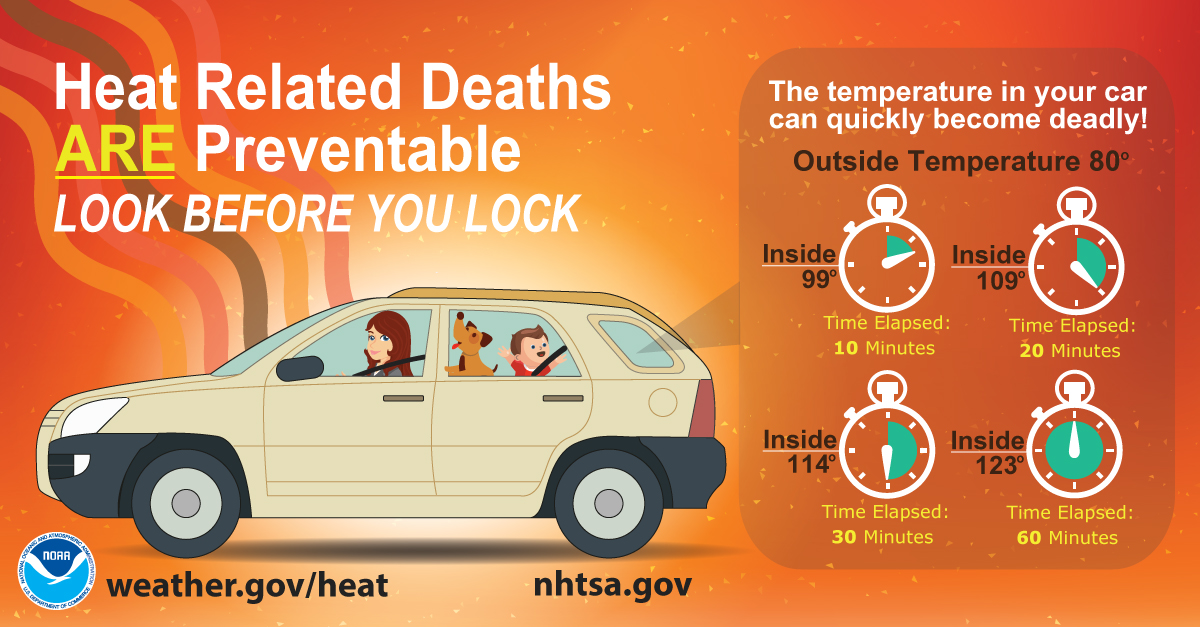
Pacific moisture will continue to bring locally heavy coastal/lower elevation rain and heavy mountain snow to the West Coast and portions of the Intermountain West through Monday. A wintry mix will create hazardous travel across the northern Plains and Upper Midwest into early Monday. Dry, gusty winds are resulting in elevated to critical fire weather in the south/central High Plains. Read More >
Heat Waves Can Kill!
|
Excessive heat can lead to serious illness and death unless precautions are exercised to prevent these dangers. When heat is forecast, especially if it is a prolonged heat spell, do not take risks and follow these safety tips to stay safe. Between 2000-2020, there were 11 fatalities in our area from excessive heat. Outside of flooding, heat is one of our biggest threats. Remember, those most at risk of heat related illness or death include small children, the elderly, and those who work outside. |
 |
Watch, Warning, and Advisory Definitions:
|
Heat Advisories |
Issued when daytime heat index values of 100°F or higher are expected. If heat index values are in the in 95° to 99°F range for four (4) or more days, an advisory might also be considered. (Note: if advisory criteria is met for 4 days or more, Excessive Heat Warnings should be considered.)
A heat advisory means that people can be affected by heat if precautions are not taken. The issuance of a heat advisory is important to raise public awareness that these precautions need to be taken. Heat advisories are also used to trigger other actions like the opening of cooling centers and changing outdoor work requirements, etc. |
 |
|
Excessive Heat Warnings |
Criteria for an Excessive Heat Warning is a heat index of 105° F or greater and a minimum heat index of 75°F or greater for at least 48 hours. Excessive Heat Warnings may also be issued when advisory criteria is met for four (4) or more consecutive days.
A heat warning means that some people can be seriously affected by heat if precautions are not taken. In addition to raising public awareness, the issuance of a heat warning will alert hospitals and officials to take certain actions to prepare and respond to an increase in emergency calls, and activate programs to check on elderly and the home-bound. In some cases cooling centers can be open or designated and donation programs activated for fans and air conditioners. |
 |
|
Excessive Heat Watches |
Issued when Heat Warning criteria is possible (50-79%) 1 to 2 days in advance.
|
Heat Index:
The Heat Index is a measure of how hot it really feels when relative humidity (or the dew point) is factored in with the actual air temperature. It is also known as the "apparent temperature" or "real feel". The heat index is often used to make decisions on advisories or warnings as an impact to health.
Here is a graphic showing the highest Heat Index over the next 24 hours.
You can view current conditions here (heat index values are calculated at 95°F or higher).
|
|
HEAT INDEX using Temp and Dew Point
|
HEAT INDEX using Temp and RH
|
Heat Index Forecasts (Days 3 thru 7):
|
|
|
|
|
|
 |
 |
 |
 |
 |
|
|
|
|
|
|
 |
 |
 |
 |
 |
|
|
|
|
|
|
 |
 |
 |
 |
 |
|
Medical: Seek out medical attention for any heat-related symptoms. |
 |
|
Heat Cramps:
Heat Exhaustion:
Heat Stroke:
|
 |
Safety Rules:
BEFORE the heat strikes:
DURING a heat wave:
Graphics:
 |
 |
 |
 |
| "Heat Safety Wherever You Are" | "Look Before You Look" | "Safe In The Heat" | Heat Index Chart |
Links:
|
|
|
 |
Please acknowledge the NWS as the source of information accessed from this site. |  |